GREAT NEWS! YOU CAN FIND THE FULL TUTORIAL HERE
If there is one thing I get asked at markets, it’s how do I make a little quilt from charm squares. And I would always send people off to other people’s tutorials. But here it is. Finally. At last. How I make my quick charm square quilts. No nonsense. Just basic steps. I’m no quilt expert but this is how I do it and it works well for me.
What you’ll need
1 pack charm squares (each pack contains 42 x 5 inch squares)
cotton thead for your machine (I just use regular Gutterman poly/cotton in white or neutral)
1m of 100% cotton fabric for backing (at least 110cm wide)
1m batting (I use cotton batting but whatever you have or is in your budget)
pins ( I like to use quilting pins with little flower at the end. They are cute, long and easy to find)
quilters safety pins
about 4m bias binding (I use premade 100% cotton binding available at Spotlight/patchwork stores but you can make your own. I’ll talk about that later)
What to do
1. Open up your charm squares and lay them out on a flat surface. You can choose a random pattern with colours and patterns all over the place. Or go in diagonals with all of the same print in one diagonal and another design next to it. It’s up to you. I like 7 squares down by 6 across and that is what I’ve assumed for this tutorial but it’s up to you. For a table runner you might like 3 or 4 across and more squares down. You choose. If you’re really getting stuck then take a picture and decide if you are happy with the layout.
2. now we are going to join our squares together. We are going to go down vertically joining each square to the square above us so we will have a row of 7 (if you’ve chosen a 7 down by 6 across quilt). Then you’ll do the next row and you’ll keep going until you have 6 rows of strips. I use a 1/4 inch seam on my squares and have a 1/4 inch foot for my machine. You can pick them up easily if your machine doesn’t come with it. It’s up to you .
If you are starting out and don’t have a 1/4 inch foot or are confused use your regular seam allowance that you would use sewing (say 1/2 inch) and be consistent the whole way through. If you can get a 1/4 inch foot it’s a great investment and the seam allowance used in quilting. Alternatively you can measure 1/4 inch out from the centre needle position on the machine and place some tape down on the needle plate and use that as your guide.
3. So pin your first 2 squares together, make sure all edges are matching up, pin carefully down the sides you are joining together. And starting from top to bottom sew down in an even line. Make sure the edge of your fabric is in line with the edge of your 1/4 inch foot or the guide you are using. This will ensure you have neat stitches and matching seams when it all comes together.
4. Now press your seams to one side or open flat. You can press your seams all in the one direction or press darker fabric seams away from the lighter fabric. It’s up to you. I like to go darker or patterned fabric pressed over to the darker fabric side or which ever way the seam wants to go. Repeat for all of your rows and be consistent with whether you’re pressing open or to a side.
5. Now we are going to join our rows together. We are going to join our first row to the second row and press. Then we will join the next row (our 3rd row) to the two we have already joined and so on. So with right sides together and starting with your first square you want to pin down the seam ensuring the seams are aligned in each corner. So where you have joined 2 squares together will match where you have joined 2 squares together on the other row. This means your corners will match on the finished quilt.
Pin well (I like to pin a few cm’s in from the edge of the fabric so I can leave my needles in. Some people like to pin either side of the seams and sew over the pins. It’s up to you and what you’re comfortable with.
6. Now with your first 2 rows pinned together (right sides together) you are going to sew down from top to bottom in a straight line. I use a 1/4 inch seam allowance but remember to use the same seam allowance you did joining your squares together. Just be consistent.
Now take your 3rd row and pin it to the 2nd row. Sew again from top to bottom. Then take your 4th row and pin to the 3rd row (which now has 3 rows joined together). Press your seams. some people like to press seams open but I prefer to press to one side. You choose. There are no rules. You can also press your seams after each row which I have done in the above picture.
7. Ta da you have a finished quilt top. Now it’s ready to quilt it. You will need batting about an inch bigger than your quilt top all the way around. I like 100% cotton batting. You can pick up batting at any large craft store or patchwork store. Sometimes you’ll find the patchwork stores have better pricing on batting as they use Australian batting whereas Spotlight stocks batting from the US which costs more (about $19-$24 a metre). If you’re just starting out you can find polyester batting but I really like natural batting when it comes to making quilts. It’s washes and dries well and your quilt becomes softer over time.
8. You’ll need the same amount of backing fabric as your batting or just a smidge larger. Check out the bargain tables at your nearest patchwork store, Spotlight or Lincraft (in the quilting sections) Or look for quilters muslin or homespun. Just remember to use 100% cotton which your quilt top is made from. I use clearance fabrics from my wholesaler as I go through a lot of quilt backings. Try to pick up a colour in the quilt top/fabric range and find it in your backing fabrics. If you get stuck or want to use the range then just buy a metre or so in the fabric range you’ve used for the charm square.
9. Iron your quilt backing fabric and lay design side down (wrong side facing up) on a table/clean floor. Tape down the corners and sides with some sticky tape. You can also do this on a clean carpet (I say clean because nothing worse than getting some crumbs, a strand of hair or bits on your lovely quilt or in between the layers. Ewwww. If you do it on carpet you can pin down your fabric using dress pins to the carpet. Smooth it out so there are no wrinkles.
10. Next up laying the batting down on top of the fabric. Smooth out any wrinkles and tape/pin through both layers (batting and fabric). You are making what is called your quilt sandwich. Now lay your nicely pressed quilt top over your batting. Smooth it out and leave about an inch or more all the way around of batting and fabric.
11. Now it’s time to pin. If you want to machine quilt your quilt then pinning is the best and easiest way. You can use a basting spray but I am wary of using them with little people around or when I’m pregnant. Which seems to be most of the time. They are pretty toxic and I don’t have a garage or suitable space outdoors to spray in. So I like to use large quilting safety pins and pin every few inches.
Pin through all layers to keep your sandwich (the layers of baking, batting and quilt top) together. I like to do a pin in each square. If you were going to hand quilt then you would baste your quilt sandwich together using big long stitches all over your quilt.
And now it’s time to quilt…………….come back for that soon in Part 2. Any questions, please just ask in the comments and I’ll get back to you! I want this to be as helpful as possible and if I’ve missed something then let me know.






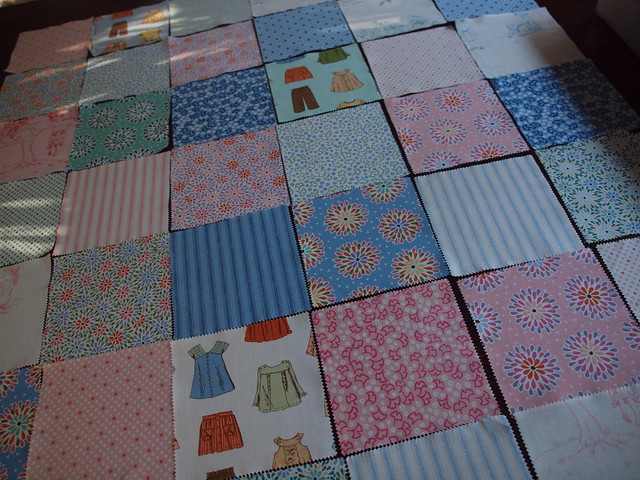


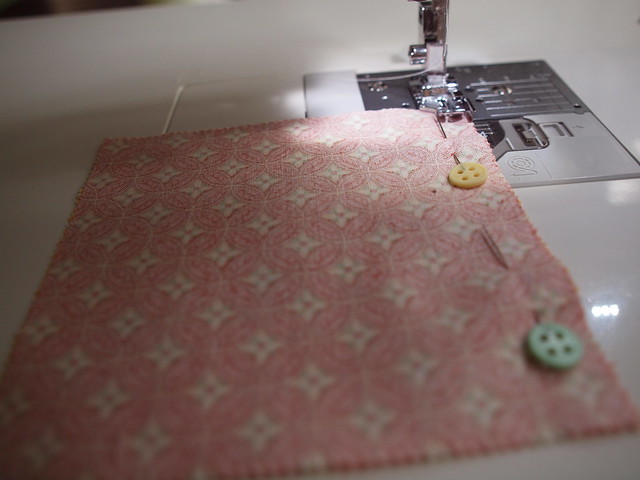
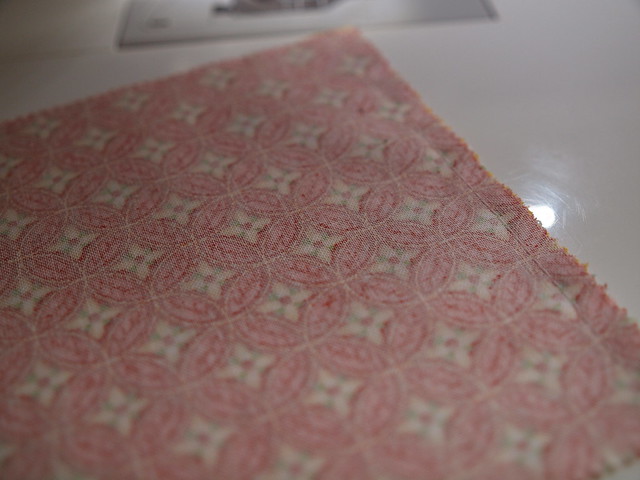
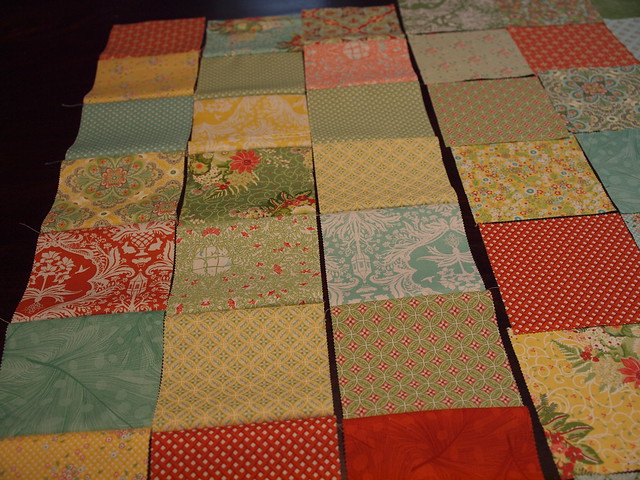
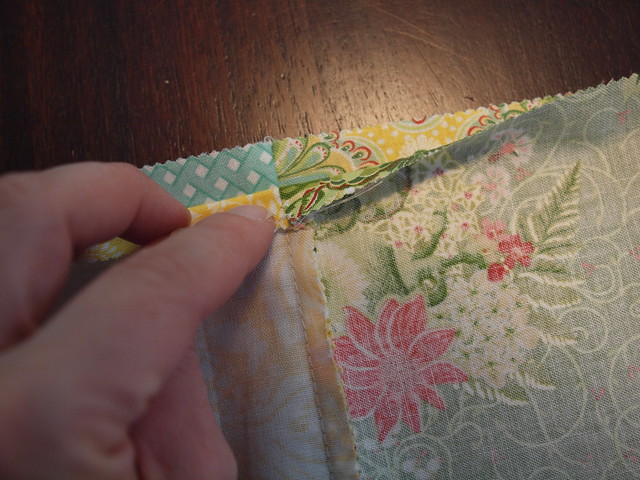
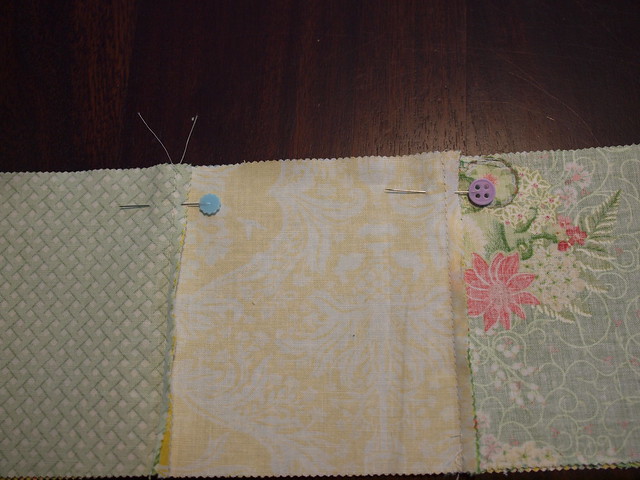
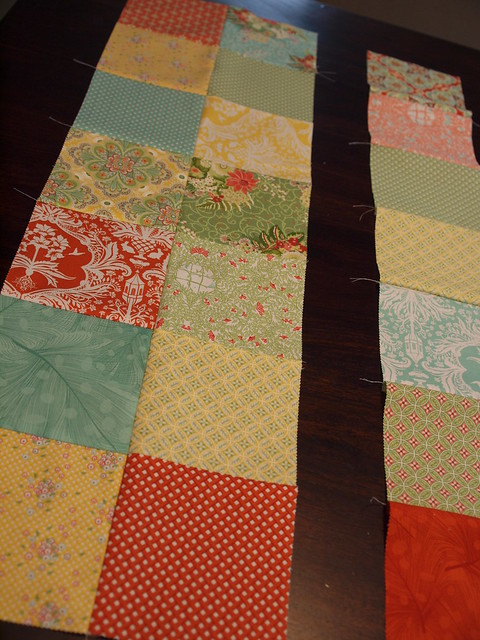

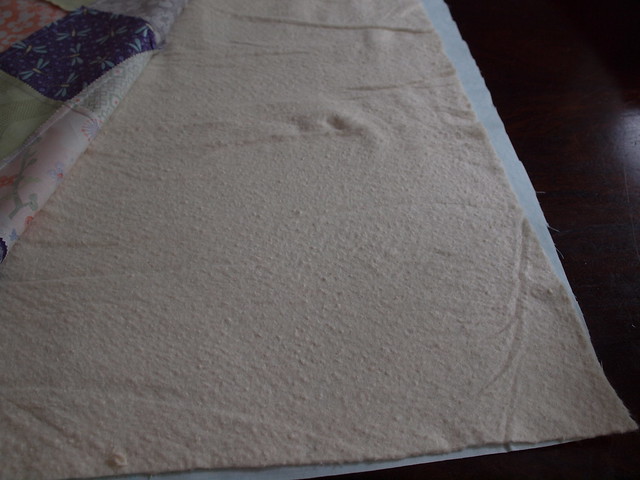

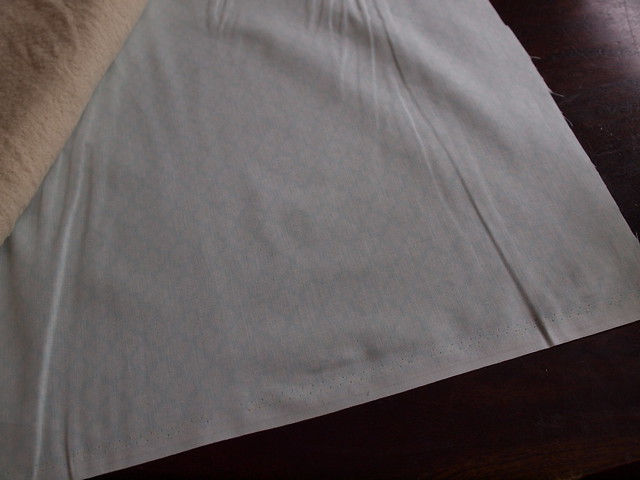
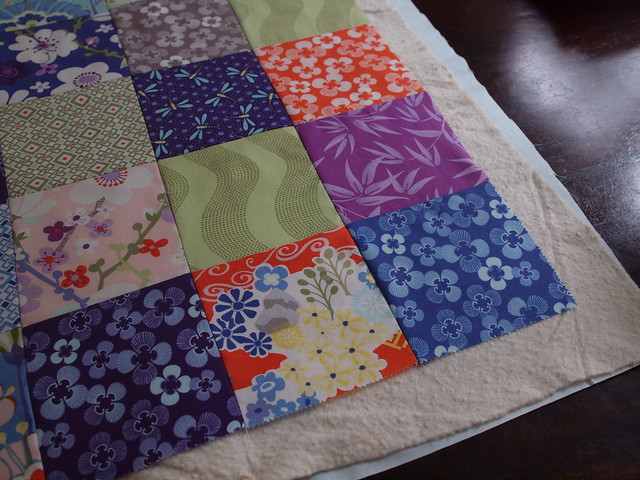
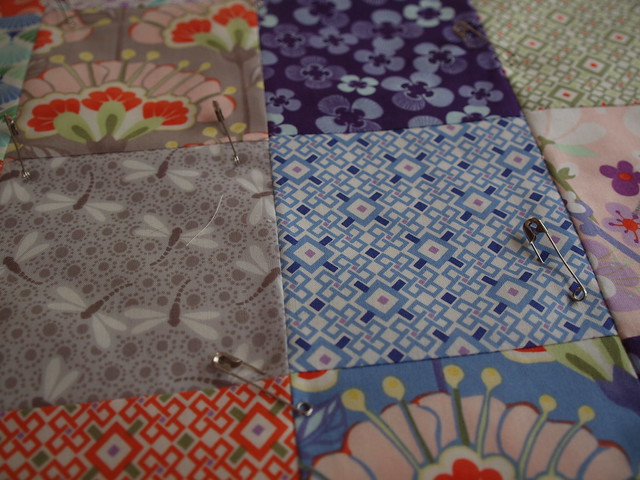




thank you very much:)
oh Corrie, thank you sweetie! This is how I would have approached it buts its so awesome to have it laid out for me step by step.
Thanks for doing this. I have a pattern for a quilt that I bought a few years ago for my girls but for some reason the thought of putting a quilt together scares me lol. But after reading your post I think I might just have to get that pattern out
Corrie, thanks so much for doing this, I have managed to make a quilt top out of a packet of charm squares but was a bit stuck about what to do next! Cant wait for Part 2!!! Btw – hope Elodie is feeling better today!
i was yet to attempt a quilt and your tute has made it seem so very doable to me,very good instructions,thankyou muchly..
Thanks so much for this tutorial Corrie. Very easy to understand. Now looking forward to completing a quilt I had begun to cut out, but could not go any further due to lack of knowledge.
I was at Mathilda’s on Sunday and purchased two jellyrolls from you, so eager to sew these in the new year.
You will not know yourself in your new kitchen – enjoy!
Now I feel like quilting-right now ! You have made that look so easy, can’t wait for part 2 ! Thanks Corrie
Thanks busy Corrie for helping we quilting novices! Much appreciated 🙂 can’t wait to get started! Also best wishes to Elodie , hope she is back into things very soon.
Wow, Corrie, thank you for sharing your brilliant tutorial with your readers. I love your clear and concise instructions.
I am off to sort through my craft cupboards for the boxes of charm squares I collected in a worldwide charm square exchange …. in the 1980’s! I might never find my way out again, that room is a minefield!
This is great Corrie. I had grand plans to make quilts for both grandma’s but it’s just not happening due to picking patterns that involve far too much piecing for now. I’m going to pull out the charm squares stashed away tonight and get started. The other quilts can wait till mothers day :-). thanks for the idea and tut. 🙂
Thanks so much, exactly what I was after!
Jen
oh yay! Looking forward to part 2. I made some festive christmas bunting today out of a pack of moda charm squares, and now have some more picked out to make a quilt like one of these. Is such a good feeling to actually ‘get’ some things made.
If you have time, please let me know when you put up part 2. I have a LOT to learn about quilting. I will look to see if you have a follow by email option too. Thanks!
Thank you, this is great! I’ve always wanted to learn to quilt and this looks like a great way to start.
Great tutorial – but now I really need to know what that red/purple/green/grey fabric is (in the last photo)?
Quick question – how big is the finished quilt
sorry to be a pain – but was there ever a part 2 to this tutorial – i couldn’t find it and i am about to start my first ever quilt!!! Thanks
Hi I am looking for part 2 as well?? also here is a silly question but im a novice; do you use a particular needle for quilting once the quilt is sandwiched?
Thanks.
The needle on the machine..i meant
Can you tell me where Part 2 is on the website? I have searched …
Thanks
Hi Corrie I love this tutorial. I was wondering where part 2 is, I can’t seem to find it. Could you perhaps pop a link at the bottom of the post for future readers? Annaleigh xxx
This tutorial is has been really helpful. Thank you! I love your fabric ensemble. I look forward to Part 2:)
I was reading about how to make a charm square quilt part 1 but I can’t find part 2 so could you tell me where to find it. I would appreciate it very much. thanks
Hi, you can find it here http://brotherinspires.brother.com.au/quilt-project/
thanks
Corrie:)